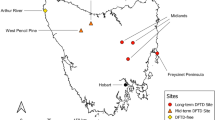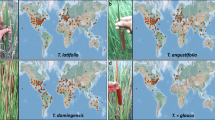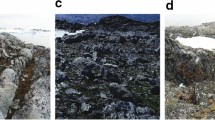Abstract
Removing exotic vertebrates from islands is an increasingly common and potentially effective strategy for protecting biodiversity. Yet, surprisingly few studies evaluate large-scale effects of island removals on native plants. We surveyed 431 hectares of habitat in 7 canyons on Santa Rosa Island just after exotic herbivore control began (1994–1996), and again after two herbivore species had been eradicated and ~ 90% of herbivores removed (2010–2012). We searched for 68 endemic and/or rare native plant taxa, mapping and recording abundances for the 39 found. Initially most of these 39 species were absent from most canyons (79.9% species-canyon combinations). Nearly 35% of absences changed to presences by 2010–2012, while only 5.5% of presences changed to absences. Thirty-six of these 39 species increased in total area, and 38 increased in total abundance. Graminoids increased more and shrubs less than other life histories, for both apparent colonizations and abundances. Beta diversity and species turnover between canyons was high at both surveys. Although a diversity of the 39 located taxa showed substantial gains, nearly half remained uncommon in 2010–2012. These results reinforce the devastating effects of exotic vertebrate herbivores on island native plants, particularly long-lived, slow-growing species. They also demonstrate significant potential benefits of exotic herbivore removal even without other active restoration, not only for vegetative cover but for a number of rare taxa. Our surveys were more spatially extensive than most post-removal studies; high spatial turnover in these data suggests that larger-scale monitoring may be critical to capture full effects of exotic animal removal.




Similar content being viewed by others
Availability of data
All data are available as a geodatabase through the U. S. Geological Survey ScienceBase repository.
Code availability
Not applicable.
References
Allen RB, Lee WG, Rance BD (1994) Regeneration in indigenous forest after eradication of Norway rats, Breaksea Island, New Zealand. New Zeal J Bot 32:429–439. https://doi.org/10.1080/0028825X.1994.10412930
Baselga A, Orme CDL (2012) Betapart: An R package for the study of beta diversity. Methods Ecol Evol 3:808–812. https://doi.org/10.1111/j.2041-210X.2012.00224.x
Baselga A, Orme D, Villeger S, et al (2018) Package betapart: Partioning beta diversity into turnover and nestedness version 1.5.1 https://cran.r-project.org/package=betapart
Bastille-Rousseau G, Gibbs JP, Campbell K et al (2017) Ecosystem implications of conserving endemic versus eradicating introduced large herbivores in the Galapagos Archipelago. Biol Conserv 209:1–10. https://doi.org/10.1016/j.biocon.2017.02.015
Bellingham PJ, Wiser SK, Wright AE et al (2010) Disperser communities and legacies of goat grazing determine forest succession on the remote Three Kings Islands, New Zealand. Biol Conserv 143:926–938. https://doi.org/10.1016/j.biocon.2010.01.001
Beltran RS, Kreidler N, Van Vuren DH et al (2014) Passive recovery of vegetation after herbivore eradication on Santa Cruz Island, California. Restor Ecol 22:790–797. https://doi.org/10.1111/rec.12144
Blackburn TM, Bellard C, Ricciardi A (2019) Alien versus native species as drivers of recent extinctions. Front Ecol Environ 17:203–207. https://doi.org/10.1002/fee.2020
Bowen L, Van Vuren D (1997) Insular endemic plants lack defenses against herbivores. Conserv Biol 11:1249–1254. https://doi.org/10.1046/j.1523-1739.1997.96368.x
Bullock DJ, North SG, Dulloo ME, Thorsen M (2002) The impact of rabbit and goat eradication on the ecology of Round Island, Mauritius. In: Veitch CR, Clout MN (eds) Turning the tide: the eradication of invasive species. IUCN SSC Invasive Species Specialist Group, Cambridge, U.K., pp 53–63
California Department of Fish and Wildlife BDB (2018) How to Read CNDDB Quad Overlays. 1–3. https://nrm.dfg.ca.gov/FileHandler.ashx?DocumentID=116370&inline
Caujape-Casells J, Tye A, Crawford DJ et al (2010) Conservation of oceanic island floras: Present and future global challenges. Perspect Plant Ecol Evol Syst 12:107–129. https://doi.org/10.1016/j.ppees.2009.10.001
Chapuis JL, Frenot Y, Lebouvier M (2004) Recovery of native plant communities after eradication of rabbits from the subantarctic Kerguelen Islands, and influence of climate change. Biol Conserv 117:167–179. https://doi.org/10.1016/S0006-3207(03)00290-8
Clark RA, Halvorsen WL, Sado A et al (1990) Plant communities of Santa Rosa Island, Channel Islands National Park. Cooperative Park Studies Unit, Technical Report No. 42. (p. 88)
Cole K, Liu G (1994) Holocene paleoecology of an estuary on Santa Rosa Island, California. Quaternary Research 41:326–335. https://doi.org/10.1006/qres.1994.1037
Courchamp F, Chapuis J, Pascal M (2003) Mammal invaders on islands: impact, control and control impact. Biol Rev 78:347–383
Davidson AD, McEachern AK, Coonan TJ, Bean WT, Armstrong AJ, Hudgens BR (2019) Natural resource condition assessment: Channel Islands National Park. Natural Resource Report NPS/CHIS/NRR—2019/1899. National Park Service, Fort Collins, Colorado. https://irma.nps.gov/DataStore/Reference/Profile/2259718
Dibblee TW, Ehrenspeck HE (2002) Geology of Santa Rosa Island, California. In: Browne D, Mitchell KL, Chaney HW (eds) Proceedings of the Fifth California Islands Symposium. Santa Barbara Museum of Natural History, Santa Barbara, CA, pp 115–126
Donlan CJ, Tershy BR, Croll DA (2002) Islands and introduced herbivores: conservation action as ecosystem experimentation. J Appl Ecol 39:235–246. https://doi.org/10.1046/j.1365-2664.2002.00710.x
Donlan J, Croll DA, Tershy BR (2003) Islands, exotic herbivores, and invasive plants: their roles in coastal California restoration. Restor Ecol 11:524–530. https://doi.org/10.1046/j.1526-100X.2003.rec0259.x
Erskine Ogden JA, Rejmánek M (2005) Recovery of native plant communities after the control of a dominant invasive plant species, Foeniculum vulgare: Implications for management. Biol Conserv 125:427–439. https://doi.org/10.1016/j.biocon.2005.03.025
Gizicki ZS, Tamez V, Galanopoulou AP et al (2018) Long-term effects of feral goats (Capra hircus) on Mediterranean island communities: results from whole island manipulations. Biol Invasions 20:1537–1552. https://doi.org/10.1007/s10530-017-1645-4
Griffin PC, Schoenecker KA, Gogan PJP, Lubow BC (2009) Survey of Ungulate Abundance on Santa Rosa Island, Channel Islands National Park, March 2009. Open-file Report 2009–1243. https://pubs.er.usgs.gov/publication/ofr20091243
Hamann O (1993) On vegetation recovery, goats and giant tortoises on Pinta Island, Galápagos, Ecuador. Biodivers Conserv 2:138–151. https://doi.org/10.1007/BF00056130
Harter DE, Severin DI, Seo B et al (2015) Impacts of global climate change on the floras of oceanic Islands—Projections, implications and current knowledge. Perspect Plant Ecol Evol Syst 17:160–183
Howald G, Donlan CJ, Galván JP et al (2007) Invasive rodent eradication on islands. Conserv Biol 21:1258–1268. https://doi.org/10.1111/j.1523-1739.2007.00755.x
Hughes G, Cohan A, White M, Brown E (2014) Subalpine vegetation change 14 years after feral animal removal on windward east Maui, Hawai’i. Pacific Sci 68:19–31. https://doi.org/10.2984/68.1.2
Jones HP, Holmes ND, Butchart SHM et al (2016) Invasive mammal eradication on islands results in substantial conservation gains. Proc Natl Acad Sci 113:4033–4038. https://doi.org/10.1073/pnas.1521179113
Kier G, Kreft H, Ming T et al (2009) A global assessment of endemism and species richness across island and mainland regions. Proc Natl Acad Sci 106:9322–9327
Klinger RC, Schuyler P, Sterner JD (2002) The response of herbaceous vegetation and endemic plant species to the removal of feral sheep from Santa Cruz Island, California. In: Veitch CR, Clout MN (eds) Turning the tide: the eradication of invasive species. IUCN SSC Invasive Species Specialist Group, Cambridge, U.K., pp 141–154
Lombardo CA, Faulkner KR (1999) Eradication of Feral Pigs from Santa Rosa Island, Channel Islands National Park, California. In: Browne DR, Mitchell KL, Chaney HW (eds) Proceedings of the Fifth California Islands Symposium. Minerals Management Service, pp 300–306
McCreless EE, Huff DD, Croll DA et al (2016) Past and estimated future impact of invasive alien mammals on insular threatened vertebrate populations. Nat Commun 7:1–11. https://doi.org/10.1038/ncomms12488
McEachern AK, Thomson DM, Chess KA (2009) Climate alters response of an endemic island plant to removal of invasive herbivores. Ecol Appl 19:1574–1584. https://doi.org/10.1890/08-1574.1
McEachern K, Atwater T, Collins PW et al (2016) Managed island ecosystems. In: Mooney HA, Zavaleta ES (eds) Ecosystems of California. University of California Press, Berkeley, pp 755–779
Myers N, Mittermeier RA, Mittermeier CG et al (2000) Biodiversity hotspots for conservation priorities. Nature 403:863–868
NPS (2013) Historic American Buildings Survey Santa Rosa Island Historic Ranching District. HABS No. CA-2738. 1–13
Prior KM, Adams DC, Klepzig KD, Hulcr J (2018) When does invasive species removal lead to ecological recovery? Implications for management success. Biol Invasions 20:267–283. https://doi.org/10.1007/s10530-017-1542-x
Reaser JK, Meyerson LA, Cronk Q et al (2007) Ecological and socioeconomic impacts of invasive alien species in island ecosystems. Environ Conserv 34:98–111. https://doi.org/10.1017/S0376892907003815
Rick TC, Sillett TS, Ghalambor CK et al (2014) Ecological change on California’s Channel Islands from the Pleistocene to the Anthropocene. Bioscience 64:680–692. https://doi.org/10.1093/biosci/biu094
Schweizer D, Jones HP, Holmes ND (2016) Literature review and meta-analysis of vegetation responses to goat and European rabbit eradications on islands. Pacific Sci 70:55–71. https://doi.org/10.2984/70.1.5
Scott JM, Goble DD, Wiens JA et al (2005) Recovery of imperiled species under the Endangered Species Act: The need for a new approach. Front Ecol Environ 3:383–389. https://doi.org/10.1890/1540-9295(2005)003[0383:ROISUT]2.0.CO;2
Simberloff D, Keitt B, Will D et al (2019) Yes we can! Exciting progress and prospects for controlling invasives on islands and beyond. West North Am Nat 78:942–958. https://doi.org/10.3398/064.078.0431
Skurski TC, Rew LJ, Maxwell BD (2019) Mechanisms underlying nonindigenous plant impacts: a review of recent experimental research. Invasive Plant Sci Manag 7:432–444. https://doi.org/10.1614/IPSM-D-13-00099.1
Smith DG, Shiinoki EK, VanderWerf EA (2006) Recovery of native species following rat eradication on Mokoli’i Island, O’ahu, Hawai’i. Pacific Sci 60:299–303. https://doi.org/10.1353/psc.2006.0012
Socolar JB, Gilroy JJ, Kunin WE, Edwards DP (2016) How should beta-diversity inform biodiversity conservation? Trends Ecol Evol 31:67–80. https://doi.org/10.1016/j.tree.2015.11.005
Soininen J, Heino J, Wang J (2018) A meta-analysis of nestedness and turnover components of beta diversity across organisms and ecosystems. Glob Ecol Biogeogr 27:96–109. https://doi.org/10.1111/geb.12660
Summers R, Masukawa J, Hartman BD (2019) The influence of slope on vegetation recovery following nonnative grazer removal on Santa Rosa Island, California. West North Am Nat 78:787–798. https://doi.org/10.3398/064.078.0418
van Dongen R, Huntley B, Keighery G, Brundrett M (2019) Monitoring vegetation recovery in the early stages of the Dirk Hartog Island Restoration Programme using high temporal frequency Landsat imagery. Ecol Manag Restor 20:250–261. https://doi.org/10.1111/emr.12386
Van Vuren D, Coblentz BE (1987) Some ecological effects of feral sheep on Santa Cruz Island, California. Biol Conserv 41:253–268
Whittaker RJ, Fernández-Palacios JM, Matthews TJ et al (2017) Island biogeography: taking the long view of nature’s laboratories. Science 357:885. https://doi.org/10.1126/science.aam8326
Woolsey J, Hanna C, McEachern K et al (2019) Regeneration and expansion of Quercus tomentella (Island Oak) groves on Santa Rosa Island. West North Am Nat 78:758–767. https://doi.org/10.3398/064.078.0415
Yelenik SG (2019) Long-term impacts of exotic grazer removal on native shrub recovery, Santa Cruz Island, California. West North Am Nat 78:777–786. https://doi.org/10.3398/064.078.0417
Yelenik SG, Levine JM (2010) Processes limiting native shrub recovery in exotic grasslands after non-native herbivore removal. Restor Ecol 18:418–425. https://doi.org/10.1111/j.1526-100X.2009.00598.x
Zavaleta ES (2004) It’s often better to eradicate, but can we eradicate better? In: Veitch CR, Clout MN (eds) Turning the tide: the eradication of invasive species. IUCN, Gland, pp 393–403
Zavaleta ES, Hobbs RJ, Mooney HA (2001) Viewing invasive species removal in a whole-ecosystem context. Trends Ecol Evol 16:454–459. https://doi.org/10.1016/S0169-5347(01)02194-2
Acknowledgements
We thank participants in a 1993 National Park Service workshop with local expert botanists that selected target plants; S. Chaney, L. Johnson, and D. Rodriguez for help with project development and field support; and C. Schwemm, L. Dye, S. Bednar, and R. Rudolph for assistance with spatial databases and analyses. Any use of trade, firm, or product names is for descriptive purposes only and does not imply endorsement by the U.S. Government.
Funding
Funding was provided by the U.S. National Park Service, the National Biological Survey, National Science Foundation grant DEB-0950106, the U.S. Geological Survey, and the W.M. Keck Science Department.
Author information
Authors and Affiliations
Contributions
D. Thomson: Conceptualization, Formal Analysis, Funding Acquisition, Investigation, Project Administration, Writing- Original Draft Preparation. A. McEachern: Conceptualization, Data Curation, Funding Acquisition, Investigation, Project Administration, Writing- Reviewing and Editing. E. Schultz: Data Curation, Investigation, Supervision. K. Niessen: Data Curation, Investigation, Supervision. K. Chess: Data curation, Investigation, Methodology. D. Wilken: Investigation, Methodology. L. Chan: Data Curation, Investigation. J. Phillips: Data Curation, Investigation. R. Oliver: Data Curation, Investigation. A. Tucker. Data Curation, Investigation.
Corresponding author
Ethics declarations
Conflicts of interest:
The authors have no conflicts of interest to report for this work.
Additional information
Publisher's Note
Springer Nature remains neutral with regard to jurisdictional claims in published maps and institutional affiliations.
Supplementary Information
Below is the link to the electronic supplementary material.
Rights and permissions
About this article
Cite this article
Thomson, D.M., McEachern, A.K., Schultz, E.L. et al. Diverse native island flora shows rapid initial passive recovery after exotic herbivore removal on Santa Rosa Island, California. Biol Invasions 24, 1635–1649 (2022). https://doi.org/10.1007/s10530-022-02735-4
Received:
Accepted:
Published:
Issue Date:
DOI: https://doi.org/10.1007/s10530-022-02735-4




